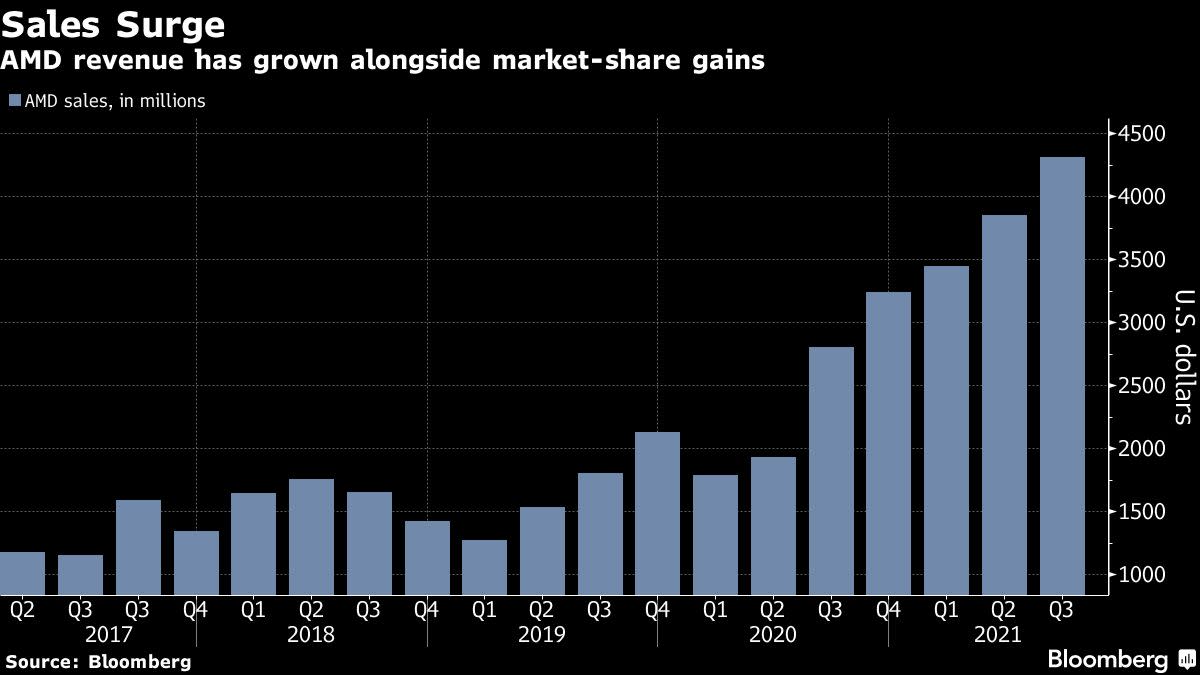AMD Soars After Server-Chip Demand Helps Brighten Forecast

(Bloomberg) — Advanced Micro Devices Inc. jumped as much as 10% in late trading after providing a surprisingly strong forecast for the current quarter, fueled by market-share gains and demand for server chips.
Most Read from Bloomberg
First-quarter revenue will be $5 billion, plus or minus $100 million, AMD said Tuesday in a statement. That compares with an average analyst estimate of $4.33 billion. Fourth-quarter results also topped Wall Street projections.
AMD, long an underdog in the chip industry, ended 2021 with record revenue — up more than threefold from its annual sales five years ago. After pouring money into AMD’s stock since Chief Executive Office Lisa Su took over in 2015, investors have been waiting for more evidence that the company can continue to gain on the once-dominant Intel.
AMD shares rose as high as $128.95 in extended trading after closing at $116.78 in New York. The stock had fallen 19% this year, battered by a broader downturn.
The company’s outlook helped soothe concerns that the chip industry is slowing after a pandemic-fueled boom. AMD predicted sales of about $21.5 billion this year, compared with an analyst projection of $19.3 billion.
The company’s gross margin — the percentage of sales remaining after deducting the cost of production — will be about 51% this year, AMD said. That target, which is in line with estimates, is similar to Intel’s profitability.
Under Su, AMD has developed leading-edge components — something her predecessors struggled to do. That’s led more chip customers to ditch Intel in favor of AMD. But Intel CEO Pat Gelsinger, who took the helm last year, is now claiming his company is offering better PC processors than AMD.
AMD data-center sales, including chips used by companies such as Alphabet Inc.’s Google and Amazon.com Inc.’s AWS, doubled last year compared with 2020. Intel said last week that demand for those chips was strong from corporations, but sales from the biggest providers of cloud computing fell.
In contrast with those remarks, AMD said Tuesday that demand increased from its cloud customers, which are deploying its Epyc server chips in their data centers.
AMD is also the second-largest maker of graphics chips used in add-on cards by PC gamers. It competes in that market with Nvidia Corp. and will face fresh opposition from Intel, which has begun offering products for that segment for the first time in years.
AMD, based in Santa Clara, California, supplies graphics chips used in Microsoft Corp.’s Xbox and Sony Corp.’s PlayStation. Demand for the two game consoles “continues to outpace all prior generations,” AMD said in slides prepared for its earnings call.
Analysts and investors have expressed concern that surging demand for PCs, particularly the lower-end laptops needed by students and workers during the Covid-19 lockdowns, would dissipate this year.
AMD’s processors are made by Taiwan Semiconductor Manufacturing Co., which has surpassed Intel in production technology. TSMC also supplies chips to Apple Inc., Qualcomm Inc., Nvidia and many other technology companies, and the Taiwanese company is struggling to keep up with demand.
AMD reported fourth-quarter net income of $974 million, or 80 cents a share, compared with $1.78 billion, or $1.45 a share, in the same period a year earlier. Sales rose 49% to $4.83 billion.
Revenue in AMD’s enterprise and semicustom unit, which makes server and gaming console chips, rose 75% from a year earlier.
Its computing division posted a revenue increase of 32% from a year earlier. That performance was helped by increasing sales of higher-priced Ryzen processors, AMD said.
The company, which analysts once expected to run out of money, now has $3.6 billion of cash and only $313 million of debt.
AMD also said it expects to close its acquisition of Xilinx Inc. in the first quarter. Chinese regulators granted approval for the purchase, which will make AMD one of the largest makers of programmable processors and increase its ability to compete directly with Intel.
(Updates share reaction starting in first paragraph.)
Most Read from Bloomberg Businessweek
©2022 Bloomberg L.P.




